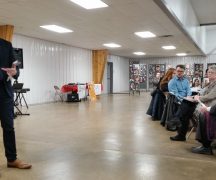The recent BG Interfaith Breakfast held at the Junior Fair Building was a success that drew 200 persons to celebrate not only different faiths but all parts of our community. Congratulations to South Side Six, Grounds, co-chairs of our peace-making breakfast, our city administrators, our school teachers and leaders, and our citizens. In fact there have been hundreds of interfaith events here and around the country: to name a few, there’s the Multi-Faith Council of NW Ohio Banquet, Temple Shomer Emumin’s Interfaith Seder, the spring National Prayer Day held annually since 1952 (sadly, ours next spring will depart from its interfaith purpose), and Al Gore’s “interfaith service” at the Atlanta Ebenizer Baptist Church where 600 persons gathered.
Most of us gather in interfaith groups at work, school, sports, card games, houses of worship, and families without recognizing them as such. We take the diversity of those groups for granted, but by calling them “interfaith,” we intentionally attend to each other, identify our religious community or none, seeking understanding of our similarities and differences, learning from them, erasing stereotypes, agreeing to live together in respect and peace.
Interfaith events are a forceful response to our toxic divisions and national polarization, fault lines that have caused anger, social fragmentation and violence. We know that each of us can be seen as “the other.” But when we are truly together, friendships are born. When we sponsor interfaith dinners, seders, climate talks, or workshops, and when we interact as real persons., we question stereotypes, there are no “others” and we reach across the tables in solidarity.
Although it is not considered religious, Edward Hicks’ painting The Peaceable Kingdom (1833) exemplifies Quaker ideals of equality, criminal and social justice, peace, protecting the earth and seeking personal wholeness and social harmony. The animals and children are taken from Isaiah 11:6–8 including the lion eating straw with the ox. Hicks used his paintings as a way to define his central interest, which was the quest for a redeemed soul. May those images of lions and oxen together enter our dreams and hopes.
Tom Klein
Bowling Green


